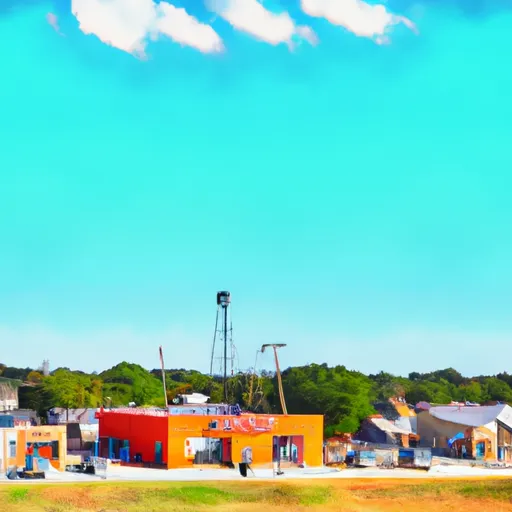-
 Snoflo Premium
Snoflo Premium
Get unlimited access to all our content
With no Ad interruptions! - Start Your Free Trial Login with existing account
Haileyville
Eden Index
Climate
8.2
•
Recreation
0.9
•
Community
1.6
•
Safeguard
4.0/10

Haileyville, Oklahoma is a small town located in Pittsburg County, with a humid subtropical climate. Summers are hot and humid, while winters are mild and occasionally frosty. The town is situated close to Eufaula Lake, which provides opportunities for boating, fishing, and other water sports. The area is also rich in outdoor recreational opportunities, including camping, hiking, and birdwatching. The town is surrounded by the Ouachita Mountains, which offer scenic vistas and opportunities for mountain biking and rock climbing. The hydrology of the area is dominated by the Arkansas River Basin, which provides ample opportunities for fishing, boating, and other water activities.
What is the Eden Index?
The Snoflo Eden Index serves as a comprehensive rating system for regions, evaluating their desirability through a holistic assessment of climate health, outdoor recreation opportunities, and natural disaster risk, acknowledging the profound impact of these factors on livability and well-being.
Climate Health Indicator (CHI): 8.2
Haileyville receives approximately
1163mm of rain per year,
with humidity levels near 83%
and air temperatures averaging around
17°C.
Haileyville has a plant hardyness factor of
7, meaning
plants and agriculture in this region tend to thrive during the non-winter months.
By considering the ideal temperature range, reliable water supplies, clean air, and stable seasonal rain or snowpacks, the Climate Health Indicator (CHI) underscores the significance of a healthy climate as the foundation for quality living.
A healthy climate is paramount for ensuring a high quality of life and livability in a region, fostering both physical well-being and environmental harmony. This can be characterized by ideal temperatures, reliable access to water supplies, clean air, and consistent seasonal rain or snowpacks.
Weather Forecast
Streamflow Conditions
Lower Canadian
Area Rivers
Lower Canadian
Snowpack Depths
Lower Canadian
Reservoir Storage Capacity
Lower Canadian
Groundwater Levels
Recreational Opportunity Index (ROI): 0.9
The Recreational Opportunity Index (ROI) recognizes the value of outdoor recreational options, such as parks, hiking trails, camping sites, and fishing spots, while acknowledging that climate plays a pivotal role in ensuring the comfort and consistency of these experiences.
Access to outdoor recreational opportunities, encompassing activities such as parks, hiking, camping, and fishing, is crucial for overall well-being, and the climate plays a pivotal role in enabling and enhancing these experiences, ensuring that individuals can engage in nature-based activities comfortably and consistently.
Camping Areas
| Campground | Campsites | Reservations | Toilets | Showers | Elevation |
|---|---|---|---|---|---|
| Governor Jim Hogg RV Park - Quitman | None | 394 ft | |||
| Lake Holbrook Park - West | None | 383 ft | |||
| Lake Holbrook Park - South | None | 379 ft | |||
| Sanders Cove - Pat Mayse Lake | 90 | 541 ft | |||
| Lake Quitman Park | None | 414 ft | |||
| Lamar Point - Pat Mayse Lake | None | 506 ft | |||
| Kiamichi Park - Hugo Lake | None | 464 ft | |||
| Pat Mayse East - Pat Mayse Lake | 25 | 504 ft | |||
| Pat Mayse West - Pat Mayse Lake | 85 | 481 ft | |||
| Hugo Lake - Kiamichi State Park | None | 468 ft |
Catastrophe Safeguard Index (CSI):
The Catastrophe Safeguard Index (CSI) recognizes that natural disaster risk, encompassing floods, fires, hurricanes, and tornadoes, can drastically affect safety and the overall appeal of an area.
The level of natural disaster risk in a region significantly affects safety and the overall livability, with climate change amplifying these risks by potentially increasing the frequency and intensity of events like floods, fires, hurricanes, and tornadoes, thereby posing substantial challenges to community resilience and well-being.
Community Resilience Indicator (CRI): 1.6
The Community Resilience Indicator (CRI) recognizes that education, healthcare, and socioeconomics are crucial to the well-being of a region. The CRI acknowledges the profound impact of these elements on residents' overall quality of life. By evaluating educational resources, healthcare accessibility, and economic inclusivity, the index captures the essential aspects that contribute to a thriving community, fostering resident satisfaction, equity, and social cohesion.

